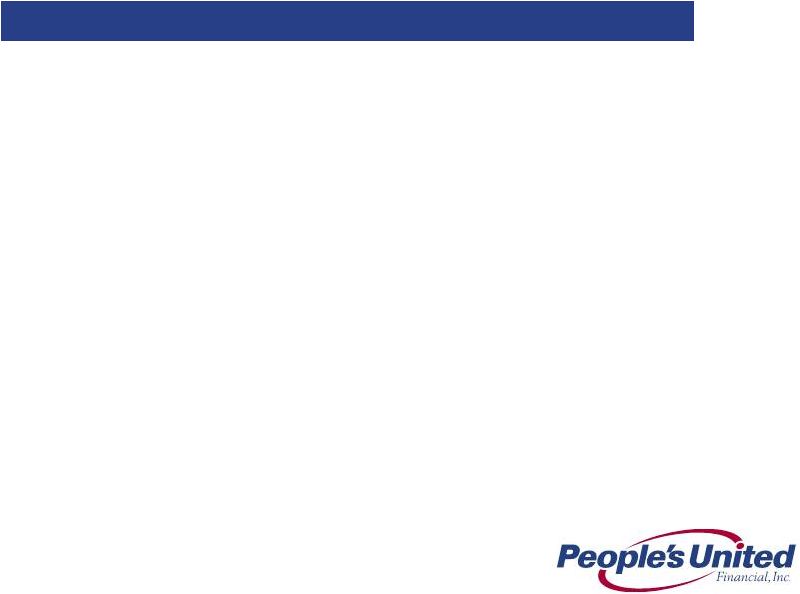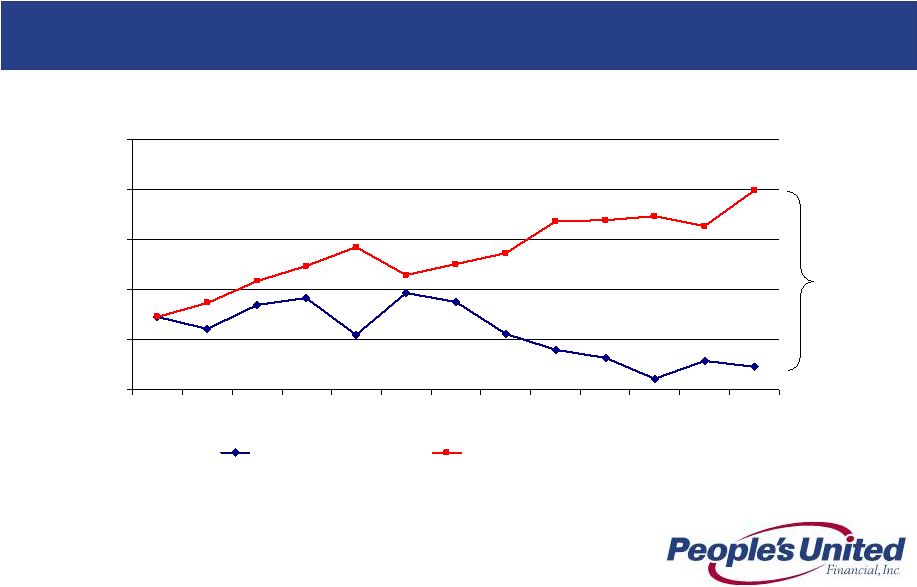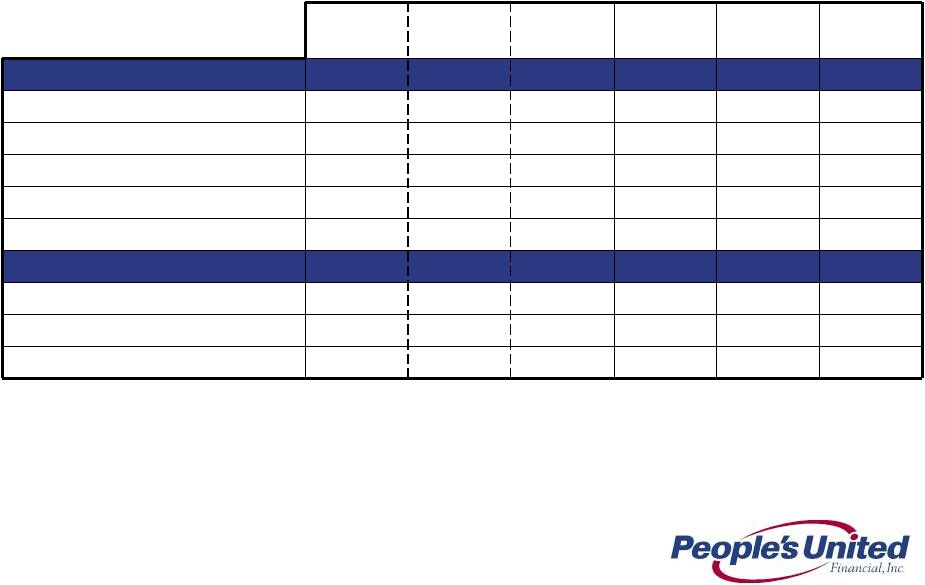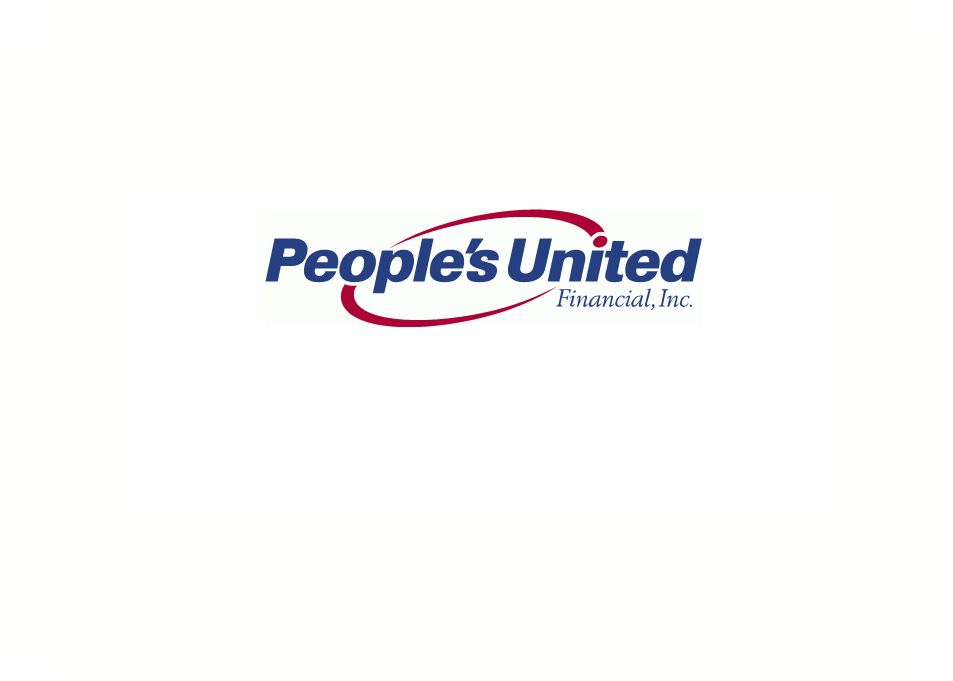 2013 KBW Boston Bank Conference February 27, 2013 Investor Contact: Peter Goulding, CFA 203-338-6799 peter.goulding@peoples.com Exhibit 99.1 |
 1 Forward-Looking Statement Certain statements contained in this release are forward-looking in nature. These include all statements about People's United Financial's plans, objectives, expectations and other statements that are not historical facts, and usually use words such as "expect," "anticipate," "believe," "should" and similar expressions. Such statements represent management's current beliefs, based upon information available at the time the statements are made, with regard to the matters addressed. All forward-looking statements are subject to risks and uncertainties that could cause People's United Financial's actual results or financial condition to differ materially from those expressed in or implied by such statements. Factors of particular importance to People’s United Financial include, but are not limited to: (1) changes in general, national or regional economic conditions; (2) changes in interest rates; (3) changes in loan default and charge-off rates; (4) changes in deposit levels; (5) changes in levels of income and expense in non-interest income and expense related activities; (6) residential mortgage and secondary market activity; (7) changes in accounting and regulatory guidance applicable to banks; (8) price levels and conditions in the public securities markets generally; (9) competition and its effect on pricing, spending, third-party relationships and revenues; (10) the successful integration of acquisitions; and (11) changes in regulation resulting from or relating to financial reform legislation. People's United Financial does not undertake any obligation to update or revise any forward-looking statements, whether as a result of new information, future events or otherwise. |
 2 Corporate Overview Snapshot, as of December 31, 2012 People’s United Financial, Inc. NASDAQ (PBCT) Headquarters: Bridgeport, CT Chief Executive Officer: Jack Barnes Chief Financial Officer: Kirk Walters Market Capitalization (2/25/13): $4.4 billion Assets: $30.3 billion Loans: $21.7 billion Deposits: $21.8 billion Branches: 419 ATMs: 634 Standalone ATMs:* 83 Founded: 1842 * Includes 25 ATMs in Stop & Shop locations where a branch is not present. |
 3 9.9 0.0 2.0 4.0 6.0 8.0 10.0 12.0 14.0 16.0 Median - US Publicly Traded Banks ($1-$100BN Banks by Assets as of 4Q12) State of the Industry Return on Average Tangible Equity Source: SNL Financial and Company filings The median return on average tangible equity, since 2Q 2007, the time of our second step conversion, is below the current median cost of equity for the industry. . . Median ROATE 2Q 2007 to 4Q 2012: 8.8% |
 4 9.9 8.6 0.0 2.0 4.0 6.0 8.0 10.0 12.0 14.0 16.0 Median - US Publicly Traded Banks ($1-$100BN Banks by Assets as of 4Q12) PBCT State of the Industry People’s United Differentiation . . . Since 2Q 2010, the time of a CEO change, People’s United has significantly improved ROATE without the benefit of credit leverage which supported the returns of the industry during the same period Continued organic balance sheet growth, further profitability improvements and active capital management will continue to differentiate People’s United from the industry Median ROATE 2Q 2007 to 4Q 2012: 8.8% CEO Change Current Normalized PBCT ROATE *: 11.8% Notes: * Current Normalized PBCT ROATE is pro forma for normalized Tangible Common Equity of 7.75%, in line with peers and excludes the income related to cash & securities above the normalized 7.75% TCE/TA level Source: SNL Financial and Company Filings |
 5 2012 Results Overview / 2012 vs. 2011 Operating earnings grew 10% to $254 million Operating EPS grew 14% to $0.75 Operating return on average assets was 90 basis points, up 1 basis point Operating return on average tangible equity was 8.5%, up 130 basis points Efficiency ratio improved to 62.4% from 64.0% Asset quality remained strong NPAs as a percentage of originated loans, REO and repossessed assets improved to 1.48% NCOs to average loans remained low at 21 basis points Strong capital levels Tangible common equity to tangible assets ratio at 10.2% Dividend yield of 5% in 2012* * Using average stock price in 2012 |
 6 Branch Map |
 7 Fortified Foundation for Growth Our Relationship Based World |
 8 Strategic Vision Outlined in mid-2010 Optimize the Existing Business Continue to grow high quality, in-footprint, relationship-based C&I, commercial real estate, home equity and select residential loans Maintain conservative underwriting standards and focus on asset quality Compete on service and relationships and maintain pricing discipline Yield enhancing moves on investments without credit risk or significant duration risk Further leverage our brand Deepen our presence in NYC Metro (Westchester County and Long Island) and Greater Boston Continue to upgrade our products & services Build out our small business lending capabilities Continue to deepen wealth management and insurance relationships Improved infrastructure facilitates future growth Core systems conversion complete Our objective is to reach 1.25% ROAA |
 9 Substantial Progress Since 1Q 2010 Continued to build on our premium brand Expanding footprint into two of the largest MSAs in the country (NYC, #1 and Boston, #10) NYC MSA: 5 branches in 2010, nearly 100 branches in 2012 Boston MSA: 20 branches in 2010, nearly 60 branches in 2012 Attracted senior level talent to augment an already strong leadership team Significantly enhanced corporate governance and risk management capabilities Maintained superior asset quality with NCOs / Average Loans of 27 basis points Lowered the efficiency ratio over 15% from 76.1% in 1Q 2010 to 63.1% in 4Q 2012 Improved profitability as demonstrated by an EPS CAGR of over 100% Operating ROAA has increased 45% from 60bps in 1Q10 to 87bps in 4Q12 Returned over $1.3BN of capital to shareholders through dividends and share repurchases – 30% of our current market capitalization All of this has occurred while the US economy and economic outlook has weakened 10 Year Treasury Yield: 3.83%, Mar. 31, 2010; 1.86%, Feb. 25, 2013 |
 10 Loans Deposits Growing Future Earnings Per Share Loans and Deposits per Share $65.59 $14 $15 $16 $17 $18 $19 $20 $21 $22 $23 3Q10 4Q10 1Q11 2Q11 3Q11 4Q11 1Q12 2Q12 3Q12 4Q12 $40 $45 $50 $55 $60 $65 $70 Gross Loans ($BN) Loans per Share $65.64 $14 $15 $16 $17 $18 $19 $20 $21 $22 $23 3Q10 4Q10 1Q11 2Q11 3Q11 4Q11 1Q12 2Q12 3Q12 4Q12 $40 $45 $50 $55 $60 $65 $70 Deposits ($BN) Deposits per Share Over the past two years, loans per share and deposits per share have grown at compound annual rates of 16% and 14% |
 11 Deepening Market Presence Connecticut Massachusetts Vermont New York New Hampshire Maine Leading market position in the best commercial banking market in the US #1 in Fairfield County, CT, 64 branches, $6.1BN, 18.2% market share #5 deposit market share in New England Source: SNL Financial Branches $BN % 1 People's United 42 2.6 22.4 2 TD Bank 34 2.6 22.0 3 Merchants 33 1.2 10.6 4 RBS 21 0.9 7.3 5 KeyCorp 13 0.8 6.7 6 Northfield 13 0.5 4.3 7 Community 14 0.4 3.7 8 Union 13 0.4 3.4 9 Passumpsic 7 0.3 2.9 10 Berkshire Hills 7 0.3 2.8 Branches $BN % 1 RBS 80 6.8 24.3 2 TD Bank 72 5.4 19.3 3 B of A 29 4.9 17.5 4 People's United 29 1.4 4.9 5 Merrimack 18 1.0 3.6 6 BNH 23 0.9 3.2 7 Santander 20 0.8 2.9 8 NH Thrift 20 0.8 2.8 9 Northway 17 0.7 2.4 10 Centrix 6 0.7 2.3 Branches $BN % 1 B of A 262 54.6 25.0 2 RBS 254 30.9 14.1 3 Santander 229 18.9 8.6 4 TD Bank 157 10.8 5.0 5 Eastern Bank 99 6.8 3.1 6 Independent Bank 78 4.5 2.0 7 Middlesex 30 3.5 1.6 8 People's United 56 3.2 1.5 9 Boston Private 11 2.9 1.3 10 Century 28 2.4 1.1 Branches $BN % 1 JPM Chase 804 393.1 38.3 2 Citi 268 69.6 6.8 3 B of A 365 60.6 5.9 4 HSBC 164 57.3 5.6 5 Capital One 277 39.0 3.8 6 M&T 299 33.3 3.3 7 TD Bank 222 22.4 2.2 8 KeyCorp 269 18.3 1.8 9 Wells Fargo 87 18.0 1.8 10 First Niagara 212 16.1 1.6 35 People's United 98 2.5 0.2 Branches $BN % 1 TD Bank 55 3.7 16.4 2 KeyCorp 60 2.7 11.7 3 Bangor Bancorp 58 2.0 8.9 4 Camden National 50 1.8 8.1 5 B of A 19 1.4 6.0 6 First Bancorp 15 1.0 4.6 7 Machias 14 0.8 3.6 8 People's United 28 0.8 3.5 9 Bar Harbor 16 0.8 3.4 10 Norway 21 0.7 3.2 Branches $BN % 1 B of A 155 24.5 24.0 2 Webster 124 12.1 11.8 3 People's United 166 10.9 10.7 4 Wells Fargo 76 7.3 7.2 5 TD Bank 81 5.9 5.8 6 First Niagara 86 4.6 4.5 7 JPM Chase 52 4.5 4.4 8 Citi 20 3.0 2.9 9 Liberty 48 2.9 2.8 10 RBS 50 2.6 2.5 |
 12 Growing loans and deposits organically Continue to grow in existing markets Leverage brand in under-represented markets such as New York and Boston Lower deposit costs Improve DDA mix, commercial mix Lower deposit costs on acquired deposits Strengthen fee income Continue to reduce absolute expense levels on a pro forma basis Operating Leverage Grow Revenue While Reducing Expenses |
 13 EMOC has been fully operational since November 2011 Three person committee comprised of the CFO, Chief Administrative Officer and Chief HR Officer EMOC oversees PBCT’s noninterest expense management, implements strategies to ensure attainment of expense management targets and oversees revenue initiatives that require expenditures Provides a horizontal view of the organization Expense Management Units (EMUs) established to facilitate EMOC functions Defined EMUs include: • Technology • Operations • Real Estate Services Spending requests above $25,000 are submitted by EMU owners for approval Staffing models, staffing replacements and additions for mid-level positions and above require approval by the Committee Introduction to EMOC Expense Management Oversight Committee (EMOC) • Employment/Benefits • Marketing • Regulatory/Institutional • Depreciation/Equipment • Decentralized • Intangible Amortization |
 14 Expense Progress Estimated Cost Savings Analysis Our Q4 2012 operating expense base of $204.5MM reflects $35MM (~$140MM annualized) savings from successfully-executed expense initiatives Source: SNL Financial Note: “Pro Forma / Actual” represents PBCT operating noninterest expense and the actual expenses at the acquired institutions. Acquisition target costs fall away as the acquisitions are completed. “Without Expense Initiatives” represents PBCT operating noninterest expense and the actual expenses at the acquired institutions in 4Q09, and then applies the peer median expense growth rate in each subsequent quarter. Operating Noninterest Expense ($MM) 205 240 200 210 220 230 240 250 4Q09 1Q10 2Q10 3Q10 4Q10 1Q11 2Q11 3Q11 4Q11 1Q12 2Q12 3Q12 4Q12 Pro Forma / Actual Without Expense Initiatives $35MM Cost Savings |
 15 Expense Progress Estimated Cost Savings Analysis The $35MM in quarterly cost reductions is attributable to efforts related to acquisition cost savings and other initiatives Source: SNL Financial Note: “Pro Forma / Actual” represents PBCT operating noninterest expense and the actual expenses at the acquired institutions. Acquisition target costs fall away as the acquisitions are completed. “Without Expense Initiatives” represents PBCT operating noninterest expense and the actual expenses at the acquired institutions in 4Q09, and then applies the peer median expense growth rate in each subsequent quarter. Operating Noninterest Expense ($MM) 240 205 7 28 $0 $50 $100 $150 $200 $250 Without Expense Initiatives Announced Acquisition Savings Other Initiatives Pro Forma / Actual |
 16 Expense Management vs. Peers* Peers* grew non-interest expenses significantly more than PBCT in 2012, even while we incurred a half year of additional expenses relating to the Citizens branch acquisition Excluding costs associated with the recently acquired southern New York branches, our operating expense base remained flat at ~$800MM 0.3% 2.6% PBCT Peers* * Notes: 1. PBCT and Peers expense growth rates are based on full year ended Dec-31-12 vs. full year ended Dec-31-11 2. Peers* is defined as 12 peers of 20, including: Associated, BancorpSouth, Commerce, Cullen/Frost, EastWest, FirstMerit, Fulton, Huntington, Signature, Synovus, Webster, Zions 3. 8 peers excluded because they completed material acquisitions in either 2011 or 2012, including: CityNational, Comerica, FirstNiagara, M&T, New York Community, Susquehanna, Valley, Wintrust |
 17 Manhattan, NY (Park Ave & 47 th St.) Opened December 3, 2012 Wellesley, MA Opened November 27, 2012 Branch Re-alignment In 2012, we consolidated or sold 15 branches while we opened three traditional branches in eastern Massachusetts, Long Island and New York City |
 18 $35.2 $11.5 ($31.8) $55.5 ($40.0) ($30.0) ($20.0) ($10.0) - $10.0 $20.0 $30.0 $40.0 $50.0 $60.0 Revenue Initiatives Revenue-related Expenses Expense Reductions Operating Leverage Recent revenue initiatives with their associated expenses combined with expense reduction initiatives produced initiative related operating leverage of $56MM, which represents $0.11/share or 15% of total EPS In 2013, recent operating leverage initiatives are expected to contribute over 20% of EPS ($ in millions) Operating Leverage Initiatives Creating New Opportunities - 2012 $0.11/share 15% of Total EPS |
 19 Cross-sell Educating our employee base / breaking down silo thinking Leveraging technology 2.2 products per residential mortgage household and 3.4 products per home equity household 667,000 retail households Penetration rates are measured and monitored closely Residential mortgage, home equity, wealth management and brokerage offer large opportunities Cross-sell performance becoming an increasingly important part of compensation |
 20 2013 Goals Execution Driving Performance Grow loans in the high single digits to mid-teens Continued momentum from current initiatives combined with slower run-off from the acquired loan portfolio Increase deposits in the mid single digits Net interest income target range of $900 to $940 million Implies net interest margin in the 3.30-3.40% range Fee income growth in the mid single digits Full year operating expense target range of $815 to $825 million Maintain a fortress balance sheet with continued excellent credit quality and strong capital levels |
 21 Summary Sustainable Competitive Advantage Premium brand built over 170 years High quality Northeast footprint characterized by wealth, density and commercial activity Strong leadership team Solid net interest margin Superior asset quality Focus on relationship-based banking Growing loans and deposits within footprint - in two of the largest MSAs in the country (New York City, #1 and Boston, #10) Improving profitability Returning capital to shareholders Strong capital base as evidenced by robust Tier 1 Risk-Based and Tier 1 Common ratios |
 Appendix |
 23 For 3Q 2012 we were more than twice as asset sensitive as the estimated median of our peer group Currently for an immediate parallel increase of 100bps, our net interest income is projected to increase by ~$48MM on an annualized basis Yield curve twist scenarios confirm that we are reasonably well protected from bull flattener (short rates are unchanged, long rates fall) and benefit considerably from bear flattener environments (short rates rise, long rates are unchanged) Notes: 1. Analysis is as of 9/30/12 filings 2. Data as of 9/30/12 SEC filings; where exact +100bps shock up scenario data was not provided, PBCT interpolated based on data disclosed 3. Data as of 9/30/12 SEC filings; where exact +200bps shock up scenario data was not provided, PBCT interpolated based on data disclosed Current Asset Sensitivity Net Interest Income at Risk 1 Analysis involves PBCT estimates, see notes below Change in Net Interest Income Scenario Lowest Amongst Peers Highest Amongst Peers Peer Median PBCT Multiple to Peer Median Shock Up 100bps 2 -3.6% 6.7% 2.7% 2.8x Shock Up 200bps 3 -6.2% 13.4% 4.5% 3.4x |
 24 Notes: 1. Leverage (core) Capital represents Tier 1 Capital (total stockholder’s equity, excluding: (i) after-tax net unrealized gains (losses) on certain securities classified as available for sale; (ii) goodwill and other acquisition-related intangibles; and (iii) the amount recorded in accumulated other comprehensive income (loss) relating to pension and other postretirement benefits), divided by Adjusted Total Assets (period end total assets less goodwill and other acquisition-related intangibles) 2. Tier 1 Common represents total stockholder’s equity, excluding goodwill and other acquisition-related intangibles, divided by Total Risk-Weighted Assets 3. Tier 1 Risk-Based Capital represents Tier 1 Capital divided by Total Risk-Weighted Assets 4. Total Risk-Based Capital represents Tier 1 Capital plus subordinated notes and debentures, up to certain limits, and the allowance for loan losses, up to 1.25% of total risk weighted assets, divided by Total Risk-Weighted Assets 5. Well capitalized limits for the Bank are: Leverage Ratio, 5%; Tier 1 Risk-Based Capital, 6%; and Total Risk-Based Capital, 10% Capital Ratios Since 1Q 2010 1Q 2010 1Q 2011 1Q 2012 2Q 2012 3Q 2012 4Q 2012 People’s United Financial Tang. Com. Equity/Tang. Assets 18.7% 13.9% 11.7% 11.4% 11.2% 10.2% Leverage Ratio 1, 5 19.2% 14.5% 12.1% 11.8% 11.5% 10.6% Tier 1 Common ² 23.1% 17.1% 13.9% 13.6% 13.6% 12.7% Tier 1 Risk-Based Capital 3, 5 23.9% 17.9% 14.4% 14.1% 14.1% 13.2% Total Risk-Based Capital 4, 5 25.6% 19.4% 16.0% 15.6% 15.6% 14.7% People’s United Bank Leverage Ratio 1, 5 12.3% 11.4% 11.0% 10.9% 10.8% 9.8% Tier 1 Risk-Based Capital 3, 5 15.4% 13.9% 13.1% 13.0% 13.2% 12.2% Total Risk-Based Capital 4,5 16.3% 14.8% 14.0% 14.0% 14.1% 13.1% |
 25 Peer Group Firm Ticker City State 1 Associated ASBC Green Bay WI 2 BancorpSouth BXS Tupelo MS 3 City National CYN Los Angeles CA 4 Comerica CMA Dallas TX 5 Commerce CBSH Kansas City MO 6 Cullen/Frost CFR San Antonio TX 7 East West EWBC Pasadena CA 8 First Niagara FNFG Buffalo NY 9 FirstMerit FMER Akron OH 10 Fulton FULT Lancaster PA 11 Huntington HBAN Columbus OH 12 M&T MTB Buffalo NY 13 New York Community NYCB Westbury NY 14 Signature SBNY New York NY 15 Susquehanna SUSQ Lititz PA 16 Synovus SNV Columbus GA 17 Valley National VLY Wayne NJ 18 Webster WBS Waterbury CT 19 Wintrust WTFC Lake Forest IL 20 Zions ZION Salt Lake City UT |
 26 In addition to evaluating People’s United Financial’s results of operations in accordance with U.S. generally accepted accounting principles (“GAAP”), management routinely supplements this evaluation with an analysis of certain non-GAAP financial measures, such as the efficiency and tangible equity ratios, tangible book value per share and operating earnings metrics. Management believes these non-GAAP financial measures provide information useful to investors in understanding People’s United Financial’s underlying operating performance and trends, and facilitates comparisons with the performance of other banks and thrifts. Further, the efficiency ratio and operating earnings metrics are used by management in its assessment of financial performance, including non-interest expense control, while the tangible equity ratio and tangible book value per share are used to analyze the relative strength of People’s United Financial’s capital position. The efficiency ratio, which represents an approximate measure of the cost required by People’s United Financial to generate a dollar of revenue, is the ratio of (i) total non-interest expense (excluding goodwill impairment charges, amortization of other acquisition-related intangible assets, losses on real estate assets and non-recurring expenses) (the numerator) to (ii) net interest income on a fully taxable equivalent ("FTE") basis plus total non-interest income (including the FTE adjustment on bank-owned life insurance ("BOLI") income, and excluding gains and losses on sales of assets other than residential mortgage loans, and non- recurring income) (the denominator). People’s United Financial generally considers an item of income or expense to be non-recurring if it is not similar to an item of income or expense of a type incurred within the last two years and is not similar to an item of income or expense of a type reasonably expected to be incurred within the following two years. Non-GAAP Financial Measures and Reconciliation to GAAP |
 27 Operating earnings exclude from net income those items that management considers to be of such a non- recurring or infrequent nature that, by excluding such items (net of income taxes), People’s United Financial’s results can be measured and assessed on a more consistent basis from period to period. Items excluded from operating earnings, which include, but are not limited to, merger-related expenses, charges related to executive-level management separation costs, severance-related costs and writedowns of banking house assets, are generally also excluded when calculating the efficiency ratio. Operating earnings per share is derived by determining the per share impact of the respective adjustments to arrive at operating earnings and adding (subtracting) such amounts to (from) GAAP earnings per share. Operating return on average assets is calculated by dividing operating earnings (annualized) by average assets. Operating return on average tangible stockholders' equity is calculated by dividing operating earnings (annualized) by average tangible stockholders' equity. The operating dividend payout ratio is calculated by dividing dividends paid by operating earnings for the respective period. Operating net interest margin excludes from the net interest margin those items that management considers to be of such a discrete nature that, by excluding such items, People’s United Financial’s net interest margin can be measured and assessed on a more consistent basis from period to period. Items excluded from operating net interest margin include cost recovery income on acquired loans and changes in the accretable yield on acquired loans stemming from periodic cash flow reassessments. Operating net interest margin is calculated by dividing operating net interest income (annualized) by average earning assets. Non-GAAP Financial Measures and Reconciliation to GAAP |
 28 The tangible equity ratio is the ratio of (i) tangible stockholders’ equity (total stockholders’ equity less goodwill and other acquisition-related intangible assets) (the numerator) to (ii) tangible assets (total assets less goodwill and other acquisition-related intangible assets) (the denominator). Tangible book value per share is calculated by dividing tangible stockholders’ equity by common shares (total common shares issued, less common shares classified as treasury shares and unallocated Employee Stock Ownership Plan ("ESOP") common shares). In light of diversity in presentation among financial institutions, the methodologies used by People’s United Financial for determining the non-GAAP financial measures discussed above may differ from those used by other financial institutions. Please refer to People’s United Financial’s latest Form 10-Q regulatory filing for detailed reconciliations to GAAP figures. Non-GAAP Financial Measures and Reconciliation to GAAP |
 For more information, investors may contact: Peter Goulding, CFA 203-338-6799 peter.goulding@peoples.com |